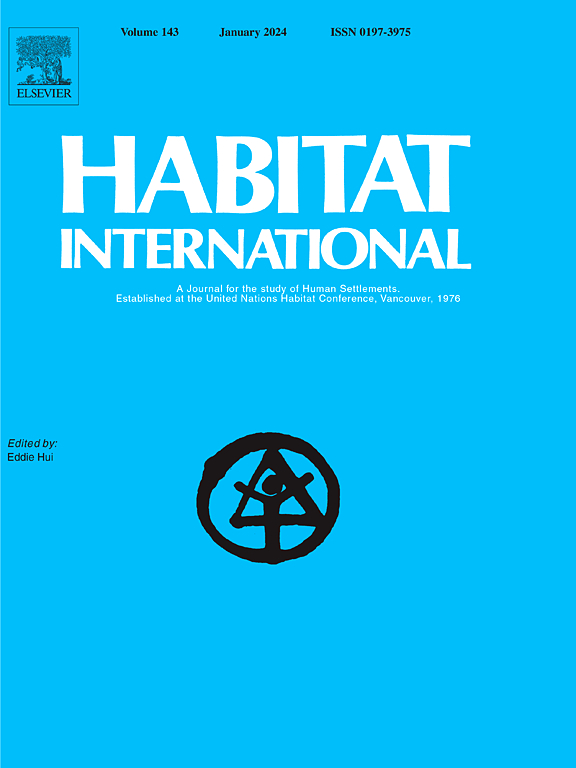约旦安曼低收入住房能源消耗的社会技术动态
IF 6.5
1区 经济学
Q1 DEVELOPMENT STUDIES
引用次数: 0
摘要
本文探讨了影响约旦安曼低收入住房能源消费模式的主要社会文化和物理因素。采用了一种定性方法,包括对安曼低收入公共住房环境中的24户家庭进行半结构化访谈和家访。分析采用双重定性方法,结合码本方法和反身性主题分析(RTA)来解释数据。研究结果表明,低收入住房的能源消耗是由社会文化习俗和物理条件的复杂相互作用形成的。舒适作为一个动态的、多维的概念出现,受到社会文化背景的影响。其核心是植根于文化和宗教的“隐私”概念,它推动了空间修改和日常实践,通常会提高能源需求。“家庭动态和社会关系”进一步影响能源消费模式。此外,“不合标准的建筑和城市设计”以及“低质量建筑材料”的使用加剧了能源效率低下,促进了更多的能源密集型行为。尽管资金有限,但与会者表现出对能源问题的显著认识,并根据文化和宗教教义实施了各种适应性战略。然而,现有的能源绩效研究往往严重依赖技术数据,而忽视了这些社会文化因素,限制了它们为有效解决能源消耗问题的设计和政策战略提供信息的能力。本研究通过整合社会文化和物理维度来弥合这一差距,为文化敏感、资源受限的环境下的住宅能源使用提供了细致入微的见解。研究结果为在文化丰富的背景下设计适合低收入社区的节能住房和支持符合可持续发展目标的政策努力提供了循证基础。本文章由计算机程序翻译,如有差异,请以英文原文为准。
Socio-technical dynamics of energy consumption in low-income housing in Amman, Jordan
This paper explores the key sociocultural and physical factors influencing energy consumption patterns in low-income housing in Amman, Jordan. A qualitative methodology was employed, consisting of semi-structured interviews and house tours conducted with 24 households in low-income public housing settings in Amman. The analysis used a dual qualitative approach, combining a codebook method with Reflexive Thematic Analysis (RTA) to interpret the data. The findings reveal that energy consumption in low-income housing is shaped by a complex interplay of sociocultural practices and physical conditions. Comfort emerged as a dynamic, multidimensional concept influenced by sociocultural contexts. Central to this is the culturally and religiously rooted notion of ‘privacy’, which drives spatial modifications and daily practices, often raising energy demands. ‘Family dynamics and social relationships’ further impact energy consumption patterns. Additionally, ‘substandard building and urban design’ and the use of ‘low-quality building materials’ exacerbate energy inefficiencies, promoting more energy-intensive behaviours. Despite financial limitations, participants demonstrated a notable awareness of energy issues and implemented various adaptive strategies informed by cultural and religious teachings. However, existing studies on energy performance often rely heavily on technical data while overlooking such sociocultural factors, limiting their ability to inform design and policy strategies that effectively address energy consumption. This study bridges that gap by integrating sociocultural and physical dimensions, offering nuanced insights into residential energy use in culturally sensitive, resource-constrained contexts. The findings provide an evidence-based foundation for designing energy-efficient housing tailored to low-income communities in a culturally rich context and supporting policy efforts aligned with sustainable development goals.
求助全文
通过发布文献求助,成功后即可免费获取论文全文。
去求助
来源期刊

Habitat International
Multiple-
CiteScore
10.50
自引率
10.30%
发文量
151
审稿时长
38 days
期刊介绍:
Habitat International is dedicated to the study of urban and rural human settlements: their planning, design, production and management. Its main focus is on urbanisation in its broadest sense in the developing world. However, increasingly the interrelationships and linkages between cities and towns in the developing and developed worlds are becoming apparent and solutions to the problems that result are urgently required. The economic, social, technological and political systems of the world are intertwined and changes in one region almost always affect other regions.
 求助内容:
求助内容: 应助结果提醒方式:
应助结果提醒方式:


